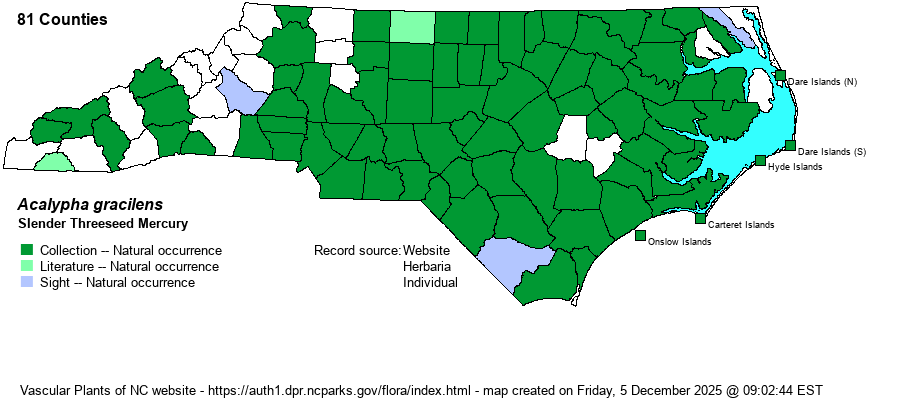| Author | A. Gray | |
| Distribution | Nearly throughout the state, but scarce in the Mountains and northwestern Piedmont.
ME to WI, south to FL and TX. | |
| Abundance | Frequent to common in the Coastal Plain and most of the Piedmont; fairly common at best in the western Piedmont, and rare in the southern Mountains. Frequently encountered, but populations are usually not large. | |
| Habitat | Woodland openings and edges, glades, fields, clearcuts, roadsides, powerlines, waste lots. | |
| Phenology | Flowering and fruiting late June-October. | |
| Identification | Unlike most of our "Euphorbs", copperleafs and threeseed mercuries have colorless, not white and milky, stem juice. Slender Threeseed Mercury grows only 1-2 feet tall, and has generally dense but very short and appressed hairs on the stem and branches (vs. spreading hairs and long leafstalks in Virginia Threeseed Mercury [A. virginica]). It has narrowly elliptical to lanceolate leaves that taper to the base. It differs from Common Threeseed Mercury (A. rhomboidea) by the shorter leafstalks and shorter teeth on the inflorescence involucres (leafy "bracts" that envelope the flowers). This is a rather easily found species in the eastern and central parts of the state, but most Acalypha species are passed over, as they have tiny flowers and are not tall or robust species. | |
| Taxonomic Comments | None
| |
| Other Common Name(s) | Shortstalk Copperleaf | |
| State Rank | S5 | |
| Global Rank | G5 | |
| State Status | | |
| US Status | | |
| USACE-agcp | FAC link |
| USACE-emp | FAC link |

